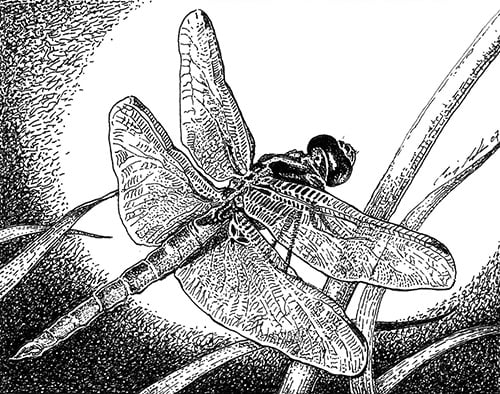

Contributor
- Topics: Archive
Within minutes of filling the old cast-iron tub with water, we were watching the aerial antics of several cardinal meadowhawk dragonflies as they swooped and darted about the garden. That is when we realized that one of the unexpected benefits of our tub, which we had sunk in the perennial border to accommodate a few aquatic plants and provide water for wildlife, would be a delightful new entertainment, easily viewed from our patio.

We are fortunate in living close to the Laguna de Santa Rosa, but many dragonflies will fly a long distance from permanent water. Damselflies, their more fragile-appearing relatives, are less frequently found far from home along natural watercourses, but some species may be found in gardens with even small water features. Dragonflies (Anisoptera) are heavybodied, large, strong fliers, with wings held flat at rest—the “cargo plane” of the Odonata. Damselflies are slender, weak fliers, with wings generally held over the top of the body at rest; a few, such as forktails (family Ishnurae) and spreadwings (family Lestidae), hold their wings open but not flat.
Dragonflies are ancient insects, having changed little since they flew around the dinosaurs, except in size: fossil dragonflies with wing spans of over two feet have been found—perhaps a bit large for the average garden! Although they have strong, serrated mandibles, dragonflies do not bite people unless roughly handled. Large, compound eyes combine with powerful mandibles to create efficient hunters, both as aquatic larvae (nymphs) and adults. Adults are voracious predators, and eat just about any flying insect. Dragonflies are said to eat their weight in mosquitoes, making them garden allies that any twilight gardener can appreciate!
Many popular names are enticement enough to want these living jewels in the garden. Some are so brilliantly colored that they warrant the names of gems: emeralds, jewelwings, amberwings, and rubyspots. Some are named for features of the specialized claspers used by males for copulation: petaltails, spiketails, baskettails, and snaketails. Other common names may reflect the distinctive flight: skimmers, pondhawks, dashers, gliders, and meadowhawks. Flight patterns are usually related to hunting style. Most dragonflies catch their prey on the wing in a basket formed with their legs. Some dragonflies mimic hawks, relentlessly pursuing their prey, while others “sally,” darting out from vegetation, then returning to their perch. Some species are hover-gleaners, picking insects from vegetation while in flight. Nymphs often hunt by ambush. The nymphs in my pond are camouflaged with algae, allowing them to sneak up on their prey, when the prehensile lip, or labium, shoots forward to snag the hapless victim. Frog ponds must be emptied at least once a year to discourage hungry dragonfly nymphs from snacking on tadpoles.
Ideally, a garden pond varies in depth. Water plants, rooted in deeper water, provide a good refuge for nymphs, as well as habitat for prey. Emergent plants, such as rushes (Juncus) and sedges (Carex), rise above shallow water and provide convenient perching places, and are important for nymphs leaving the water to molt into the final, adult stage. The lucky gardener may one day see a nymph’s exoskeleton split down the back, and watch the magical emergence of a new dragonfly. A few flat rocks near the pond’s edge provide basking spots for dragonflies and access to the water for other beneficial insects and wildlife. It is relatively easy to encourage the many species that favor still water, but those that require running water, such as the stunning rubyspot, are best enjoyed in nature. Our tub attracts several species of Odon-ata, but the recommendation is for a pond to be twenty feet across. (Have you been wondering what to do with that hard-to-maintain swimming pool you no longer use?)
Dragonfly ponds are frequented by all sorts of other aquatic insects. I have found back-swimmers, creeping water bugs, and water striders in my small tub. Many aquatic insects are predatory, but exert little pest control for the gardener. Still, kneeling on the fragrant chamomile next to my little pond, my young friends and I always have an amusing circus to observe. Odonata nymphs do not completely control mosquito larvae; there are other solutions for keeping a pond mosquito-free. I avoid fish, which find dragonfly nymphs and eggs tasty. Instead, I add mosquito dunks containing Bt (Bacillus thuringiensis), a bacteria that kills only mosquito larvae, to my pond. I am always thrilled to see wheeling dragonflies dip down to lay their eggs, and, a few days later, the appearance of tiny nymphs.
The curious circle formed by mating dragonflies is said to be the origin of the heart-shaped symbol of romance. It is comical to watch males skirmish in their efforts to access a female, sometimes butting each other aside. Some dragonflies lay eggs while in the wheel position, but many males will continue to guard a female until the eggs are laid, even when they are no longer in tandem.
Every region has its most common dragonfly species, but any that visit the garden are sure to provide pleasure. In my garden, the cardinal meadowhawk is a frequent visitor: perched with its wings bent forward, I can approach surprisingly close before it flits away, only to return minutes later to the same reed. The large red dragonfly patrolling overhead is a flame skimmer. Pond damsels are occasional visitors, and include the sapphire-colored vivid dancer and familiar bluet. I sometimes see Pacific forktails, blue-eyed darners, and other species I have yet to identify. The shimmering flight of dragonflies provides hours of entertainment, and I can no longer imagine my garden without these welcome guests anymore than I can imagine my home without friends!
In a Nutshell
Popular Names:
All Odonata may be correctly referred to as dragonflies.
Scientific Name:
Order: Odonata, Suborder: Anisoptera (dragonflies), Suborder: Zygoptera (damselflies)

Common Species:
Dragonflies: flame skimmer (Libellula saturata), cardinal meadowhawk (Sympetrum ilotum), blue-eyed darner (Aeshna multicolor). Damselflies: vivid dancer (Argia vivida), Pacific forktail (Ischnura cervula).
Distribution:
Largely a tropical group of insects; over 5,400 species worldwide. About 435 species in USA and Canada; about 60 species of dragonflies, and 40 species of damselflies distributed throughout the West Coast states. Although more species are found in southern regions, some species are only found in northern climes. Many Odonata are exclusively pond and river dwellers, rarely found far from water; others range widely as adults.
Life Cycle:
Hemimetabolous (an incomplete metamorphous from egg to aquatic larvae to adult).
Appearance:
Eggs: tiny, usually scattered over water (dragonflies) or inserted in vegetation (damselflies and a few dragonflies). Larvae: aquatic, known as nymphs; molt about a dozen times. Damselfly nymphs slender, with leaf-like gills at the end of the abdomen; dragonfly nymphs usually stout and lack leaf-like gills. Pupae: No pupal stage. Adults: dragonflies generally stout-bodied, hold wings flat at rest, with large compound eyes that often meet in the middle; damselflies usually slender, generally hold wings over the body, with eyes set widely apart.
Life Span: Nymphs live a few weeks to several years, depending on species. Adults live only a few weeks in temperate species. Adults die in winter, but nymphs overwinter in water.
Diet: Both adults and nymphs are carnivorous. Adults eat mosquitoes, gnats, and other small insects. Nymphs eat mosquito larvae, caddisfly larvae, and other aquatic prey. Larger nymphs may eat tadpoles and even small fish.
Favorite plants: Water reeds, willows, and alders, all used as perching sites.
Benefits: All species dine on mosquitoes and other garden pests, add beauty and entertainment for the gardener.
Problems: Dragonfly larvae may eat frog tadpoles.
Interesting facts: Dragonflies have a prehensile, hinged lower “lip” tipped with claws that shoots out to capture prey. Males have two sets of genitalia; mate in a wheel position.
Sources: None! Attract by adding water features to the garden.
More information: Dragonflies and Damselflies of California (Tim Manolis, UC Press, 2003) is useful throughout much of the Northwest US and Western Canada; Common Dragonflies of California:
A Beginner’s Pocket Guide (Kathy Biggs, www.sonic.net/dragonfly); The Oregon Dragonfly and Damselfly Survey (www.ent.orst.edu/ore_dfly/links.html); Dragonflies of Washington (Dennis Paulson, Seattle Audubon Society); Dragonfly Society of the Americas (https://odonatacentral.bfl.utexas.edu/dsa1/











Responses